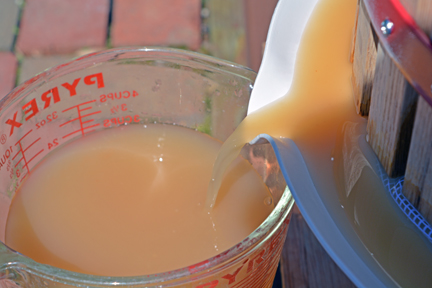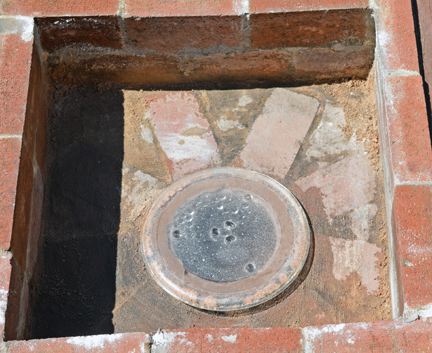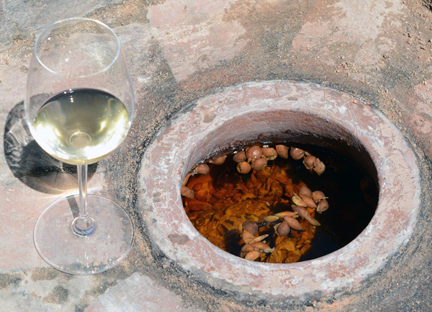On the second Sunday in April, Kathy and I racked our wine from its earthen qvevri. Our first task was to remove several cubic feet of sand covering the qvevri. The qvevri is buried below the ground level. When it was sealed in December, we filled the area with sand. Once removed, we inspected the clay seal between the glass top and the rim of the qvevri. The clay was still moist and still formed a seal around the qvevri’s opening. The glass covering did not come off easily. I had to twist it and then eventually I was able to lift a section. Working around the circumference, I was able to lift the covering. We cleaned the sand that was left surrounding the qvevri. We also removed the clay from around the rim.
The Vidal Blanc grapes were harvested on October 3, 2016 from Harvest Ridge Winery in Marydel, Delaware. Once harvested, we destemmed and crushed the grapes. The juice and many of the skins were placed in the 24-liter qvevri. Fermentation took a week. Once completed, a temporary covering with an airlock was placed over the qvevri opening. During the remainder of October and through November, malolactic fermentation took place. We replaced the temporary covering with a permanent covering in December by placing a coil of clay around the qvevri rim and pressing a piece of glass into the clay. Since we used glass, we could see through the glass and see the clay. There were no gaps. We then covered the qvevri and surrounding area with sand.
Now in April, it was time to rack the wine to a carboy to settle. The first few inches of wine at the top of the qvevri was clear. Then we could see the skins. Of course we tasted the wine. The yellow colored wine had an aroma of flowers. The mouthfeel was velvety and reminded me of jammy yellow-stoned fruits. The wine had mild tannins. When we reached the grape skins, we transferred the skins and wine to a basket press. We had recently purchased an 18-liter basket press and this was its first use. About a gallon of free run wine was collected and added to the carboy. Adding light pressure to the press collected another half-gallon of wine.
After the first few inches of wine were racked into a carboy, the wine was cloudy. By the time we filled a couple carboys, our qvevri wine was cloudy with a lot of suspended particles. Two days later, the sediment was settling and the wine was clearing. Our plan is to rack again in May, then filter and bottle. Qvevri winemaking is an example of ancient winemaking. The egg-shaped qvevri remains buried in the ground. Some qvevris used to make wine in the country Georgia are several hundred years old. There are not many winemakers in the United States making qvevri wines. As far as we know, Kathy and I are the only people in Maryland making qvevri wine.

The wine from the press was cloudy. It will clear in a carboy for the next few weeks before filtering/
Many American wine consumers will need to be educated about qvevri white wines. Why did we ferment on the skins and macerate on the skins for a little over six months? One reason are the tannins. I always see tannins in a white wine as a gift. I like tannins. Another reason is more poetic. Georgian winemakers have told me that it is not natural for a child to be ripped from it mother at birth. Why would winemakers rip the white wine juice from it skins and seeds shortly after harvest?
Cheers,
Terry





Leave a Reply